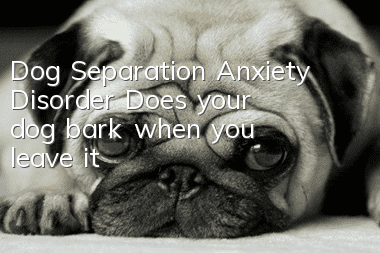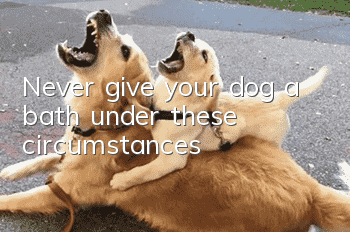Dog Separation Anxiety Disorder: Does your dog bark when you leave it?

What is the difference between separation anxiety and boredom?
Separation anxiety
If the dog howls and growls for a long time after the owner goes out, and goes back and forth in the house looking for the owner, there is If there are signs such as digging at the cage, digging at the door, or chewing things, and the duration lasts for more than half an hour, it can be basically concluded that the dog suffers from separation anxiety disorder. The severity of separation anxiety varies depending on the degree of the behavior. The main characteristic of separation anxiety is: separation → anxiety. Behavioral problems will only occur when the owner is out of sight, and will not exhibit any behavioral problems when the owner is within sight. But for some dogs who howl, dig at the cage, the door, and chew things when their owners are at home, this is not separation anxiety, they are just bored.Bored
Dogs, like people, can also be bored. Some dogs will also howl when their owners go out, but usually it is just "meaningful". They will go to sleep by themselves after humming twice. , after waking up, they will patrol the door to see if the owner is coming back soon, and then continue to sleep or drink water and eat by themselves, play with toys, etc. to pass the time. Occasionally, they will also go to the sofa to look for the owner's clothes. , but generally will not be destroyed (except for puppies in their infancy). It just misses its master and hopes that he will come back soon. This phenomenon is very common. Most do not require management and will not become serious. However, there are also a few cases that are early symptoms of separation anxiety. As time goes by, this situation will get worse and worse until it develops into a real separation anxiety disorder. .How to solve dog separation anxiety
1. Reduce the sense of ritual
Dogs with separation anxiety pay unusual attention to their owners. They are always commenting on the owner’s words and deeds. When the owner is preparing to go out, they will start to get nervous and slowly become manic. Therefore, if your dog suffers from separation anxiety, please reduce your going out. "Ritual sense". That is, don’t do the same thing before going out every day, such as taking small items such as wallet keys from the shoe cabinet or the entrance, saying goodbye to the dog, dressing up repeatedly in front of the dressing mirror, getting snacks for the dog, getting specific toys, etc.
You can put your keys, wallet and other small items in your bag the night before. Don’t use the bag in the same place every day. Fill the dog’s drinking fountain with water in advance. Don’t say goodbye to the dog when you go out and close the door. Just leave.
2. Desensitization training
Reducing the sense of ritual can only reduce the dog's attention to the owner's departure, but the dog will still return to the same behavior after discovering that you are gone, so if you want to completely treat separation anxiety , desensitization training is also required.The method of desensitization training is also very simple:
Step 1: Install a pet fence on the door (similar to the picture below, choose a fence with appropriate height and width, make sureThe dog cannot turn it out and matches the door frame of your home), so that the dog can see the outside situation in the living room.
(Pet fence installed on the door)
Step 2: You "go to work" as usual. When you are about to disappear from the dog's sight, turn back, open the fence and enter the house. If the dog If the dog greets you crazily, please ignore it. Do not have any verbal or eye contact with the dog. Treat it as if it is air (some people may think it is cruel here, but you must know that separation anxiety is more cruel). After returning to the house, do your own thing. matter. After the dog calms down, go out again and repeat the last behavior. After the dog can stay quietly every time you go out and come in (it also treats you as air), you can proceed to the next step.
The third step: go out to "work" normally, disappear from the dog's sight after going out, and wait for a short period of time (after the training in the previous step, the dog has relaxed some of its "guarding" on you). The length of time may be a few seconds, it may be a few minutes, or it may be just a moment. The principle is to ensure that the dog does not bark, then return home, open the fence and enter the house, ignore the dog's welcome to you, and repeat , proceed to the next step when the dog regards your disappearance and appearance as air.
Step 4: Same as step 3, extend the disappearance time until the dog gets used to you disappearing for more than 6 hours.
Step 5: Go out, close the door, and observe the dog's condition through the camera. When the dog becomes anxious, open the door and enter the house in time. Do not communicate with the dog, do your own thing, and be the same dog as before. No, wait for the dog to calm down, then give him an appropriate reward, and then start doing your own thing. After the dog calms down again, go out again, repeat the above behavior, until the dog gets used to you closing the door and leaving and can be quiet. Waiting for your return.
Step 6: Complete, remember not to do the same thing every time before going out, and don’t accept the dog’s warm welcome ceremony every time you come home. Wait until the dog calms down before interacting with the dog.
Notes
Training Dog behavior is a test of patience and perseverance. Some behaviors may only take a few minutes while others may take months. Once the behavioral habits are formed, they must be consolidated frequently to maintain them. Therefore, if you want your dog to have good behavior If you are used to it, you must maintain enough patience and perseverance, and you must not rush for success. The result of rushing for success will only make you get twice the result with half the effort, and bring more trouble to the dog and yourself.
Some friends may I once sent my dog to a pet training school for training. When the dog first came home, the training effect was indeed gratifying, but as time went by, the old habits recurred. This was the reason for the lack of maintenance and the lack of maintenance of good behavior. Dogs can also be lazy and forgetful, so if you send your dog to a pet training school next time, you must ask the dog trainer for advice on maintenance issues after training. Only by strengthening daily management and maintenance can the good behavior continue.< br />
- golden retriever pregnancy process
- What should I do if my dog doesn’t eat the new dog food?
- How to train an aggressive dog? Train a very aggressive dog!
- What should I do if my dog has dystocia? A must-read for emergency measures for dog dystocia!
- What are the symptoms of canine distemper in dogs? The early symptoms of canine distemper!
- Symptoms and treatment methods of epilepsy in dogs
- Do dog owners need to be vaccinated?
- The Origin and History of the Australian Cattle Dog
- Simple methods and precautions for making homemade dog food
- What training method should you choose to train your dog? How to get good results



